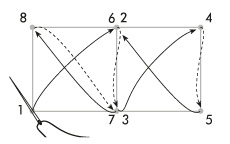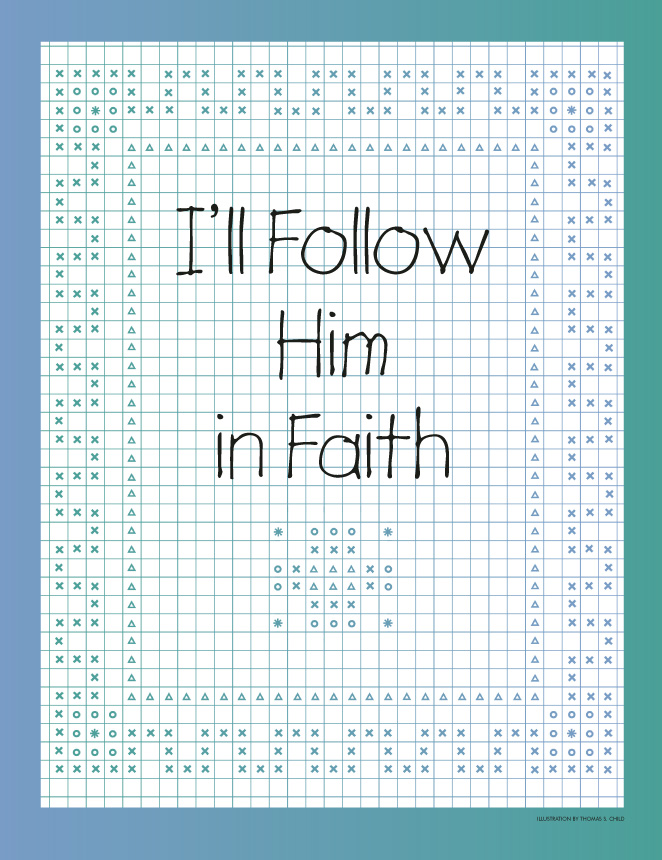“I’ll Follow Him in Faith,” Friend, Feb. 2007, 14–16
Sharing Time: I’ll Follow Him in Faith
And we believe and are sure that thou art that Christ, the Son of the living God (John 6:69).
Have you ever played follow the leader? The rules are simple: choose a leader and then follow him or her.
The purpose of our life on earth is to follow our leader Jesus Christ. When Jesus saw Peter and Andrew fishing, He said to them, “Follow me.” Peter and Andrew left their nets and followed Him (see Matthew 4:18–20).
Just like He did to Peter and Andrew, Jesus invites each of us to follow Him (see D&C 100:2). We will probably not walk exactly where He walked, but we can do the things that He did. We can read the scriptures. We can pray to our Heavenly Father. We can be baptized.
After Peter followed Jesus, Peter declared, “We believe and are sure that thou art that Christ, the Son of the living God” (John 6:69). When we follow Jesus Christ in faith, we can have that same testimony.
Our faith in Jesus Christ will grow when we understand more about Him. And the more we know about Him, the easier it will be to follow Him in faith.
Activity
To make a cross-stitch sampler, color each symbol on page 14. To stitch the sampler, trace the pattern onto plain fabric, like muslin. Use three strands of embroidery floss in the color of your choice for each symbol. Ask an adult to show you how to make a cross-stitch over each symbol. (See illustration.) Display your sampler where you’ll see it often.


Illustration by Thomas S. Child
Note: This activity may be copied or printed from the Internet at www.lds.org. Click on Gospel Library.
Sharing Time Ideas
(Note: All songs are from Children’s Songbook unless otherwise noted; GAK = Gospel Art Picture Kit, TNGC = Teaching, No Greater Call.)
1. Display the children’s names as well as the names of several ancient prophets on wordstrips. Ask what all of these names have in common. Let the children brainstorm ideas (see “Brainstorming,” TNGC, 160–61). Read together Abraham 3:22–24, and explain that we all lived with Heavenly Father in the premortal life. Tell the children that we do not remember our lives before earth, but because of the scriptures, we know a little of what happened there. Ask the children to find out which of all of God’s spirit children was the firstborn by looking up D&C 93:21.
Several Primary songs talk about our premortal life. Play a listening game using songs listed under “Premortal Existence” in the topical index of the Children’s Songbook. Have the pianist play first one measure, then two measures of a song. Keep adding a measure until the children guess the name of the song. After the children guess the song, sing the entire song, pointing out the lines that tell about our life with Heavenly Father before we came to earth.
Explain that we were all spirit brothers and sisters in the premortal life. We call each other “brother” or “sister” because those titles reflect our spiritual relationship to each other. Bear testimony that we are spirit children of Heavenly Father. Sing “I Am a Child of God” (pp. 2–3).
2. Show the children several examples of plans. For instance, you could show a recipe, a blueprint for a house, or instructions for putting together a toy. Explain that when we put something together—such as a house, a batch of cookies, or a toy—it is best to know what will happen in the end. We need a plan.
Before we came to the earth, Heavenly Father presented His plan. It is called the plan of salvation. Invite the full-time missionaries or a recently returned missionary approved by the bishop or branch president to teach the plan of salvation, from Preach My Gospel (pp. 47–59). Remind the presenters beforehand that the presentation must be simple enough for children.
For older children: Ask the children to figure out what order the songs in “The Savior” section (pp. 34–83) of the Children’s Songbook are in. Read through the titles of the songs. Give them hints to help them discover that the songs are in chronological order. The section includes songs about the prophecy of His birth, His childhood and ministry, His Resurrection, our desire to be like Him, and His Second Coming. You could make wordstrips for each of these parts of the Lord’s life.
Sing songs about different parts of His life, pointing out that Jesus Christ is essential to the plan of salvation. Testify that He is the Savior of the world.
3. Create a display showing some of the beauties of the earth. You could show pictures of animals, flowers, plants, and foods. Ask the children to think about the beautiful world we live in as they hear a song. While the pianist plays “My Heavenly Father Loves Me” (pp. 228–29), pass around a flower, and ask the children to look carefully at it. Notice the veins, the softness, the wonderful smell. Ask the children, “Who made the flower?” (Jesus Christ—it was part of the Creation.) Ask, “Why did He make the flower?” (Because He loves us and wants us to live in a beautiful world.) Sing “My Heavenly Father Loves Me,” and hold up the flower when they sing the line, “Whenever I touch a velvet rose.” Challenge the children to remember Heavenly Father’s love every time they see a flower.
Give each child a piece of paper and some crayons. Ask them to draw a picture of one of God’s creations. To create a reverent atmosphere, have the pianist play songs from the “Nature and Season” section of the Children’s Songbook (pp. 228–49). When the children have completed their drawings, display them on a wall in the Primary room or on a large sheet of paper to create a mural. Let the children walk by and enjoy the pictures.
For younger children: Using 11 different pieces of colored paper, teach the poem “Colors of Our World” (Friend, Feb. 2006, 7). Put the colors in order, and each time a color is mentioned, have a child hold up that color. Repeat several times, and bear testimony that the lovely things in the world were created for us.
4. Ask the children what a miracle is. (A miracle is an amazing or unusual occurrence that cannot always be explained logically. It shows the power of God.) Have them share examples of what a miracle could be, such as the sun not setting at night or manna appearing on the ground each morning. Look up 2 Nephi 27:23. Point out two things: that God is a God of miracles and that He works according to our faith.
Divide the children into four groups. Choose four miracles listed in the Bible Dictionary under “Miracles.” Several days before Primary, ask four Primary leaders to discuss a miracle that the Lord performed while on the earth. For example, discuss how He cleansed the 10 lepers (see Luke 17:12–19), healed a blind man (see Mark 8:22–26), and so on. Use four stations (see “Stations,” TNGC, 179), and have the children rotate to each station. Ask each leader to explain that Jesus Christ performed miracles to show His power and to bless the people. Ask each to bear testimony of the Savior.
Sing “Jesus Is My Friend” (Friend, Oct. 1992, 5), focusing on the second verse. Remind the children that Jesus performed miracles to bless others. The people were blessed because of their faith.
5. Song presentation: “This Is My Beloved Son” (p. 76). You may want to teach this song in several successive weeks, giving more attention to the story contained in each verse. Divide the children into three groups. Assign each group one of the first three scriptures listed at the bottom-right corner of the music: Matthew 3:16–17; 3 Nephi 11:6–8; Joseph Smith—History 1:17. Ask the children to listen as each scripture is read and discover what they all have in common. In these scriptures, Heavenly Father introduces His Son and bears testimony of Him. Sing the last line of the song, “This is My Beloved Son. Hear Him!” Have the children sing the line with you several times. Ask what was happening in the first scripture that they read (Jesus was baptized). Display GAK 208 (John the Baptist Baptizing Jesus) as you sing the first verse. Have the children join you when you sing the last line. Repeat, having the children sing all of the words. Ask what was happening in the second scripture (Jesus appeared to the Nephites). Display GAK 315 (Christ Appears to the Nephites) as you sing the second verse. Again, have the children join you when you sing the last line. Explain that the verse says, “They heard the Father witness.” That means that Heavenly Father was bearing testimony of His Son. Have the children sing with you. Ask what was happening in the third scripture (Heavenly Father and Jesus appeared to Joseph Smith). Display GAK 403 (The First Vision) as you sing the third verse. Once again, have the children join you when you sing the last line. Explain that this time Heavenly Father was more than a voice from heaven—He was right there! Have all of the children look up D&C 18:34–36. Ask them to listen and answer the question, “Who else can hear the voice of our Heavenly Father?” Sing the final verse to find the answer. Point out that the last note of the song is different in the last verse. Have each of the three groups hold one tone to create a chord on the final “Hear Him!” (A, C, F). At the end of the song, they will hear the beautiful harmony of the chord.
6. Friend references: “The Plan of Salvation Offers Me Peace,” Mar. 1994, 14–15; “I Celebrate,” May 2002, 10; “Our Beautiful World—Part of the Plan,” Jan. 2005, 43; “God’s Love for His Children,” Apr. 1989, inside front cover; “Miracles in Our Time,” May 1998, inside front cover; “Angry People in Nazareth,” Mar. 2001, 12–13; “Miracle of the Fishes,” July 2003, 4–6; “Micah’s Miracle,” Oct. 2002, 4–6.